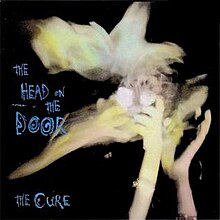Head on the Door opens portal to all sides of The Cure’s vibe

In the midst of today’s ever growing musical world, it can be hard to find anything; sometimes people don’t even know where to begin. While this may not show you every song, album or EP that you’d ever dream of hearing, let this inspire you to search and dive into the infinitely deep hole that is the modern music world.
From the streets of Crawley, England, comes what most consider to be the kings of gothic music, The Cure—currently consisting of their frontman, singer and guitarist Robert Smith; bassist Simon Gallup; keyboardist Roger O’Donnell; multi-instrumentalist Perry Bamonte; drummer Jason Cooper; and guitarist Reeves Gabrels. In this article, we’re covering their 1985 album, The Head on the Door.
The Cure as a band can come in many different shades, different emotions and sounds in their music. Albums like Disintegration sit on this purplish black edge of oblivion, of sheer depression and hopelessness, while albums like Wish will still carry dark topics with it, but it’s emotions are much clearer, not drowning in a sea of black, but more in a sea of vibrant reds and blues. So where does Head on the Door stand? Let us find out.
Head on the Door teeters on its tone, not being overly depressing, but not being joyous either; it, like many Cure albums, is a very emotionally driven album. It’s also what I would consider to be a very strange album, as in quirky. Some songs feel out of left field, in a good way, of course, like Six Different Ways, Close to Me and In Between Days, all popular songs from Head on the Door, but both don’t exactly follow the same downer guitar and bass format that most Cure songs do.
Don’t be mistaken however, this is still definitely an album by the kings of goth, with tracks like A Night Like This giving us that downer sound, the guitar droning on and the drums sounding hollow as they play along.
Another important thing to note is the vocals; Smith’s voice goes between desperate pleading and genuine pain as he sings. All of this playing comes together over a story about a betrayed lover who is wanted back even after what has happened.
The Cure are not only kings of goth, but also masters of scene-setting. They can create an atmosphere with just some simple playing. They can make calming, slightly silly at points in their settings, or they can make the setting more eerie, like you’re walking in a forest surrounded by dead trees, feeling like you’re the only one around, but also like you’re not exactly alone either.
Head on the Door was originally an album by The Cure that I skipped out on, not because I didn’t want to listen to it, but I was simply infatuated with their other albums and their sound, but coming back to Head on the Door, I realize it’s a good mix of everything that The Cure encompasses. Throughout this review I’ve used the words “Kings of Goth,” and while they are widely known for their darker sound, depression isn’t what The Cure is about. I believe that The Cure is about emotions, the feeling you get from different situations in life. If The Cure was just a downer band, we wouldn’t have albums like Wish or Kiss Me Kiss Me Kiss Me, albums where at that point in the singer’s life, Smith wasn’t feeling the dark mood because that’s not how he felt, and being the main songwriter, a lot of The Cure’s songs come from his emotions and experiences.
The Cure, ever since I was introduced to them and went to see them live in Minnesota, they have always held a special place deep in my heart for how vivid and raw the emotions on display were, how they were expressed through beautiful singing and amazing playing, and while they may not be one of the top bands ever, I think they deserve the recognition they’ve gotten and more. Head on the Door gets a 7/10, a great representation of what The Cure really is.









You must be logged in to post a comment Login